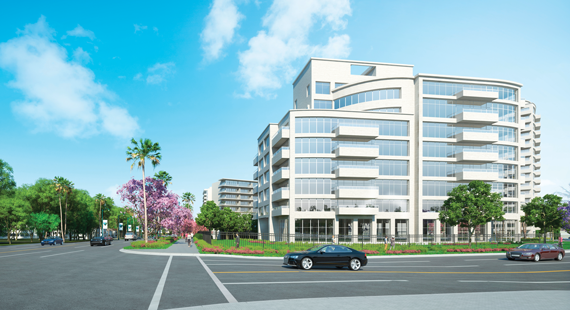Trending
The battle for Beverly Hills: How LA developers are bidding to alter the city’s skyline by any means necessary

From the L.A. print issue: It took 19 heated hearings for the City of Beverly Hills to approve developer Beny Alagem’s plan for two condo towers and a Waldorf Astoria on land surrounding his Beverly Hilton hotel. Even then, he had to face a voter referendum organized by opponents of the development, which narrowly passed in 2008.
Yet Alagem’s quest didn’t end there. The Israeli-American entrepreneur, who made his fortune founding Packard Bell Electronics in 1986, wants more. More height, specifically. His real estate firm, Oasis West Realty, wants to amend the project to take the 110 condo units that have already been green-lighted and merge them into a single 26-story structure. He’s advocating for the change while the 170-key Waldorf Astoria adjacent to the condo project is already 70 percent complete, with a scheduled opening in 2017.
Here’s the twist: Rather than pushing the project through the laborious city planning process again, Alagem wants voters to approve the changes in a ballot referendum, which has become known locally as “the Hilton initiative.”
Never before has a developer sought to use the ballot box to sidestep the rigorous Beverly Hills planning department and environmental review processes. The changes that Alagem is seeking to the approved plan — which include creating a garden in the footprint of the tower that would be eliminated — have been presented to voters as the “Beverly Hills Garden & Open Space Initiative.”
If approved, the 371,500-square-foot tower would become by far the tallest building in Beverly Hills. Standing 375 feet at its highest point, the Robert A.M. Stern Architects-designed building would eclipse the city’s tallest tower, the 165-foot Beverly Wilshire hotel.
Alagem’s efforts to make an end run around the established procedures have incensed Beverly Hills Mayor John Mirisch, who told The Real Deal that he had tried, unsuccessfully, to convince the developer to go back through the normal planning process. “This is not Legoland,” he told TRD. “You can’t just stack things on top of each other and call it a day.”
Developers at odds
Neighboring the site in question is another condo-and-hotel project that is almost as large, although not nearly as tall, as Alagem’s proposed project.
Known as One Beverly Hills, the project calls for a 134-key boutique hotel, 193 luxury condominiums and retail space at 9900 Wilshire Boulevard. Chinese billionaire Wang Jianlin’s Wanda Group is behind the proposed $1.2 billion development.

Beny Alagem
The condo tower was already approved at 728,978 square feet under previous site ownership, but Wanda is seeking permission to replace some of the condo units, and all of the retail space, with hotel rooms. It is going through the standard environmental review process to seek these revisions, even though the project’s footprint won’t change. The revised development would span a total of 901,514 square feet and rise 185 feet tall.
Michael Nourmand, the president of the luxury Beverly Hills brokerage Nourmand and Associates, said that having two luxury condo projects next door to each other in Beverly Hills inherently makes them competitors. “There is a finite number of high-end condo buyers, so too much supply in a short time period could be problematic,” he said.
Indeed, as the ballot initiative campaign nears its close, both developers have taken out advertisements in local newspapers. Alagem’s advertisements, as well as pro-initiative op-eds, fill the Beverly Hills Courier. Wanda’s ads in Beverly Hills Weekly — which also carries op-ed pieces critical of the Hilton initiative, by former mayor Mirisch — focus on the differences between the Hilton initiative and its own project, in order to “clear up the confusion.” They highlight the fact that Hilton is avoiding the standard planning processes, while Wanda is not.
“We chose a different path that allowed for community input, a thorough environmental review and consideration by the city’s planning commission and council,” Rohan a’Beckett, deputy general manager of Wanda’s Beverly Hills subsidiary, told TRD.
Wanda also formed a PAC in early August with the goal of questioning the Hilton initiative’s language on the ballot.
Alagem told TRD that neither he nor anyone involved with the Hilton initiative had ever officially opposed the One Beverly Hills project. However, the word “officially” is key: An attorney representing the initiative voiced grief over various elements of the project during its first Planning Commission meeting in August, calling it “a transportation disaster for the Hilton and the community.”
Getting out the vote
Alagem’s Oasis West Realty spent just over $3 million — widely considered to be a large sum for a local ballot measure — during the first six months of the campaign, from January 1 to June 30. During that time, the firm concluded successful signature-gathering efforts and got the measure on the ballot. Records also show Alagem hired multiple campaign consultants, attorneys and public relations firms throughout the campaign.
“They are willing to spend an unlimited amount of money to pass this, and that is unusual,” said Josh Gross, publisher and founder of Beverly Hills Weekly, adding that “it’s one of the most aggressive campaigns I’ve ever seen.”
Gross’ paper reported that the Hilton initiative had spent $6,329 during a three-month period at Tiffany’s alone. When TRD asked the campaign about that particular expenditure, a representative explained it was for giveaways at a party celebrating getting the initiative on the ballot, as well as champagne glasses to toast the occasion, naturally.
 But these costs are comparatively small next to the ultimate cost of the tower and garden, which Alagem estimated will amount to at least $350 million, with the total project cost landing somewhere around $700 million.
But these costs are comparatively small next to the ultimate cost of the tower and garden, which Alagem estimated will amount to at least $350 million, with the total project cost landing somewhere around $700 million.
“We are giving voters a decision,” Alagem said in a soft voice inflected with an Israeli accent when TRD sat down with him in his Century City office. “It’s simple … Do you want an eight and an 18-story building? Vote no. Do you want a park? Vote yes.”
Neighborhood pushback
The plan has clearly ruffled some feathers, with local residents and politicians saying the focus on the garden in the campaign’s website, advertisements and renderings — many of which don’t even show the proposed building — could be construed as deceptive.
Mirisch called the website for the initiative, “a masterpiece of hucksterism” in a public letter published in the Beverly Hills Weekly and Huffington Post.
“This is a skyscraper initiative masquerading as an open-space initiative,” Mirisch told TRD. “They’ve got a lot of money to spend, and they are counting on casual voters who like the idea of a garden. Success or failure will be based on how many fall victim.”
Marie Garvey of the Garvey Group, a spokeswoman for the Hilton initiative whose firm was paid almost $85,000 in the three-month period from April 1 to June 30, said that the garden was front and center in the marketing materials because it was the biggest change to the project. The use of the condos and the floor area would remain the same, she said.
Alagem stressed the appealing aesthetics of the luxury high-rise building, saying it would be “gently designed” to blend with the new Waldorf, which will include a restaurant by Jean-Georges Vongerichten. Robert A.M. Stern himself will be hands-on during the design, he said. An acknowledged fan of the starchitect, Alagem lived in Stern’s 15 Central Park West tower in New York until 2009.
Regardless of how the project is cast, many of its opponents say the real issue is whether the developers of major skyscraping projects should be able to use the ballot box in order to go around established land-use rules and environmental review processes.
“For the first time, a developer has chosen not to go through the local planning process,” Beverly Hills Council member Kathy Reims told a council meeting in July 2016. She cautioned that this could “open the floodgates” to additional dense development projects.
Some local residents agree. “My concern isn’t about one project or one developer; it’s really about the future of our low-rise community,” said longtime Beverly Hills resident Alma Ordaz. She said that if the initiative succeeded, “it will be open season on Beverly Hills for any developer willing to come in and spend the money.”
Two weeks after speaking with TRD, Ordaz filed a writ of mandate, which calls for the authors of the ballot to remove allegedly false and misleading language in favor of the initiative prior to the printing of the ballot pamphlet. Her lawsuit was sponsored largely by Wanda’s Beverly Hills subsidiary and its development partners, Athens Group.
Former mayors club weighs in
In Beverly Hills, the former mayors are “an institution” and “a clique,” Gross said. Some of them lobby for developers, who see them as invaluable because of how many people they know in the city and the prestige their former title carries.

A rendering of One Beverly Hills.
A handful of these former mayors are involved in the drama that surrounds the Hilton initiative and One Beverly Hills.
One former mayor, Barry Brucker, registered as a lobbyist on behalf of Wanda’s competing project in 2014, two years after leaving office. Over the summer of 2016, he was sent a letter on behalf of “anonymous citizens” who were represented by Sacramento attorney Gary Winuk. The letter, which was made public in the Los Angeles Times, claims that Brucker violated a city policy preventing former officials from working as paid lobbyists for projects that they voted on while in office. The former mayor signed on with One Beverly Hills six years after voting on it while in office.
Brucker has since resigned from the project. However, he said in a public statement that he resigned only out of an abundance of caution, and believed he was exempt from the cited rule because when he voted on the site’s use it was under different ownership and had a different site plan. He said he had never actually lobbied. “My scope of services did not include lobbying any elected or appointed official in the City of Beverly Hills,” he said. “To ensure that I was abiding by the spirit of the law, I registered as a lobbyist with the City of Beverly Hills to make my participation transparent and known.”
Wanda spokesman Eric Rose said in an emailed statement to TRD that it was “disappointing” that an “anonymous opponent” of the project would “besmirch the good reputation of Mayor Brucker for its own purposes.” He went on to describe One Beverly Hills as the “only major development project in Beverly Hills that is following the City’s environmental review process” — the only other major development in the neighborhood not following the process obviously being the Hilton initiative.
Brucker had voted against Alagem’s original plan in 2008, leading to much local speculation about whether the anonymous letter was connected to the developer. While Alagem and those involved with his campaign have denied that, suspicion remains.
Gross said the developer is being very aggressive with his opponents. “The towers were controversial when they passed in 2008, but some people, myself included, supported them. Then they were never built, and some of the people who originally supported them are mad,” he said, adding that Alagem has “unlimited funds” to fight this battle.
Meanwhile, some former mayors have come out to support the Hilton initiative. Former mayor Robert Tanenbaum, who previously opposed it, wrote op-eds in the Courier in favor of it. Former mayor Linda Briskman is a “community volunteer sponsor” of the initiative.
Perhaps most controversially, former mayor Jimmy Delshad’s company American International Business Inc. received $8,000 from the Hilton initiative in the first three months of the campaign, and $18,000 in the second three months, Beverly Hills Weekly reported. He voted “yes” on the original plan and was an outspoken supporter of the project, subjecting him to the lifetime ban against lobbying. He did not register with the city as a lobbyist.
At first, Delshad explained to TRD that he was a “community activist helping the project.” When presented with the campaign finance filings, he described himself as a “consultant” rather than a “lobbyist.”
“I was very instrumental in helping the City of Beverly Hills get a small garden next to Montage, and I see now how people love that garden,” Delshad said, referring to the luxury hotel just off Wilshire Boulevard. “I’m supporting the Hilton initiative because I think it’s a better plan now, with a garden three times as large [as the one at the Montage]. I can imagine how much more people will enjoy it, and come and play games with children, and have movie night.”
Mirisch said the lines between who is a lobbyist and who is paid in some other capacity are often blurry. “The difference between lobbyist and consultant is sometimes no more than semantics, especially if they aim to influence a legislative outcome,” he said.
What’s next
An independent report commissioned by the city projected that Alagem stood to gain $48.2 million more in profits (once all units are sold) if voters approve the Hilton initiative in November. It further projected that the city would gain $33.4 million more in taxes, based on the higher property values, over a 30-year period.
It’s estimated that the new plan for One Beverly Hills would generate $84 million in direct revenues to the city over its first 10 years of operation, an increase of more than $65 million over the previously approved project, according to a report by CBRE.
As of press time, Wanda Group was awaiting its next planning meeting, in September, and deliberating the next action of its PAC against the Hilton initiative.
Meanwhile, the Alagem campaign was preparing for its final push to make the initiative attractive to voters in November. It posted a slick new video on its website featuring images of people biking, walking through gardens strewn with fountains and a voice-over saying, “Beverly Hills is different from neighboring Los Angeles … like an oasis amidst the hustle and bustle.” The initiative is then introduced, and the soothing voice ends on, “It’s a better plan for more open space and a greener Beverly Hills.”




